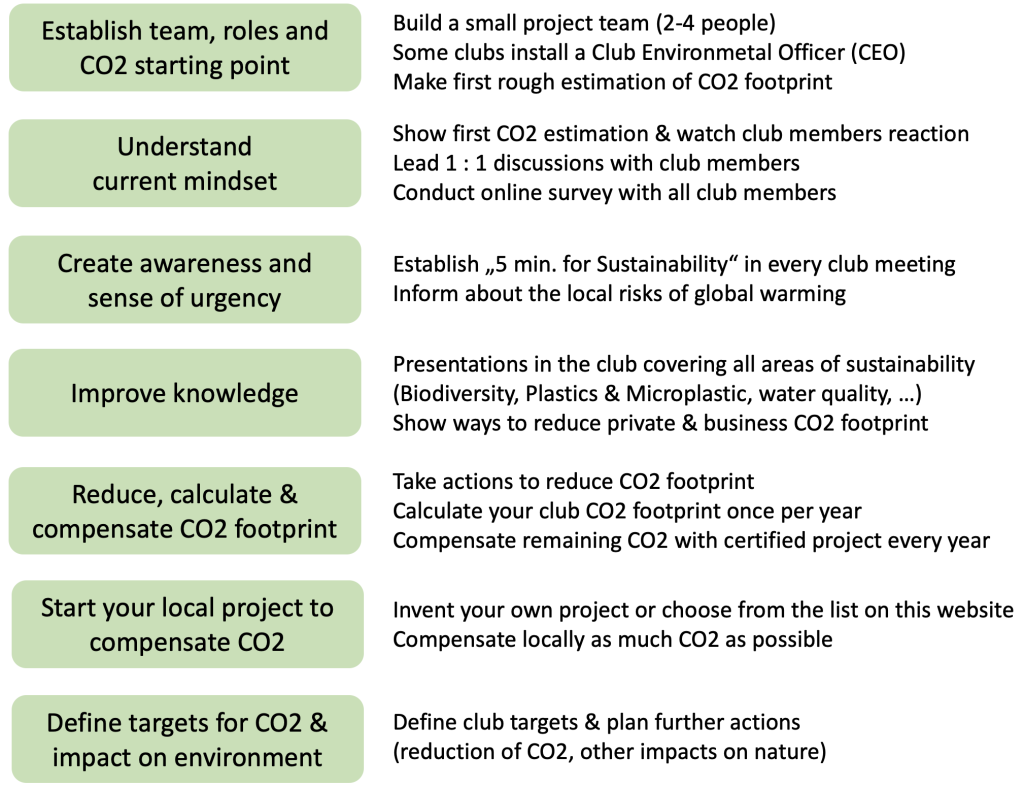To drive sustainability in your club you can take several steps. Within RC München-Residenz we conduct some of the following alternative steps. See text below the picture for more details.

Establish team, roles and CO2 starting point
The topics sustainability and climate change can be quite polarising. On the one hand there will be strong supporters of the topic. On the other hand there will be members that do not like the topic or reject it. Therefore it is not advisable to simply start an open discussion about „calculating and compensating our CO2 footprint“, because the people rejecting the topic might be much more emotional and louder than the supporters. Better start with a few phone calls or 1:1 discussions before and after meetings to identify members that will support the topic „sustainability“. E.g. you can ask „are you interested in the topic of sustainability“?
Set up a small project team „Sustainability“ in your club with 2-4 members. Look for members who are generally interested in sustainability or members that have already taken action in their private or business life.
You can also define a „Club Environmental Officer“ (CEO) in your club. A CEO is then appointed by ESRAG officially. He can ensure that the topic moves forward over the years even with changing presidents.
With the project team conduct a first rough estimation of CO2 Footprint & first compensation of CO2 Footprint. For the first estimation it is strongly recommended to work with assumptions in the project team to reduce the effort. Based on the rough estimation you can also make a first compensation of emissions to make your club carbon neutral. In the second year with better data you can improve accuracy of your calculation.
Understand current mindset
Assess the general attitude towards sustainability in the club. You can show the results of your first estimation of the CO2 footprint and watch the discussion in the club. Conduct 1:1 talks with club members, starting with the very active ones: Achieve data for calculation, inform the members, understand their mindset.
Create Awareness and sense of urgency
Use the „5 Minutes for Sustainability“ to raise awareness for sustainability topics. Depending on your club you can do that in every club meeting or only once a month. In these 5 minutes you can e.g.
– inform about possibilities to reduce CO2 during the next club events,
– each member can inform about his private actions, e.g. stopping paper mail
– members can inform about their professional sustainability actions etc.
– you can report from interesting articles you read etc.
Please subscribe to our YouTube Channel to get ideas for the 5 minutes.
Improve the knowledge
Enhance the knowledge in the club about sustainability and climate change. Use Presentations in the club as an important action – here you can get our presentations and additional hints
Reduce, calculate & compensate CO2 footprint
Extend your „club meeting attendance list“ to collect the data for a more accurate calculation of the CO2 footprint.
Define an action plan for your club to reduce Carbon emissions and implement the actions – you can get an example action plan via email to contact@becomesustainable.org
Calculate and compensate your CO2 emissions on a yearly base. The decision to do this every year could be taken to the club membership assembly. Here you will find evaluated alternatives to compensate the CO2 footprint of your club.
Start your local project to compensate CO2 emissions
Relying on other peoples projects to compensate CO2 emissions will not be sufficient in the long run. Instead we should aim to reduce our CO2 emissions where we create them. Invent your own project or choose from our list of possible local projects to reduce CO2 emissions. We will also help you to calculate the effect of your project. Please contact us via email to contact@becomesustainable.org.
Define targets for CO2 and impact on environment
Once the mindset of sustainability is well established in the club you can define a CO2 target for the club and establish an action plan to achieve the target. You can also discuss other impacts of the club concerning water usage, avoiding waste, biodiversity, …
Feel free to change the sequence of the steps. Please send us your experiences, ideas and actions with these, other or additional steps via email to contact@becomesustainable.org
